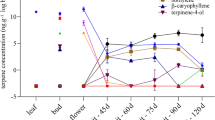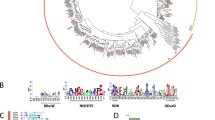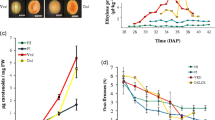Abstract
A combined chemical, biochemical and molecular study was conducted to understand the differential accumulation of volatile sesquiterpenes in melon fruits. Sesquiterpenes were present mainly in the rinds of climacteric varieties, and a great diversity in their composition was found among varieties. Sesquiterpenes were generally absent in non-climacteric varieties. Two climacteric melon varieties, the green-fleshed ‘Noy Yizre'el’, and the orange-fleshed ‘Dulce’ were further examined. In ‘Noy Yizre'el’ the main sesquiterpenes accumulated are δ-cadinene, γ-cadinene and α-copaene, while α-farnesene is the main sesquiterpene in ‘Dulce’. Sesquiterpene synthase activities, mainly restricted to rinds of mature fruits, were shown to generate different sesquiterpenes in each variety according to the compositions found in rinds. EST melon database mining yielded two novel cDNAs coding for members of the Tps gene family termed CmTpsNY and CmTpsDul respectively, that are 43.2% similar. Heterologous expression in E. coli of CmTpsNY produced mainly δ-copaene, α-copaene, β-caryophyllene, germacrene D, α-muurolene, γ-cadinene, δ-cadinene, and α-cadinene, while CmTpsDul produced α-farnesene only. CmTpsNY was mostly expressed in ‘Noy Yizre'el’ rind while CmTpsDul expression was specific to ’Dulce’ rind. None of these genes was expressed in rinds of the non-climacteric ‘Tam Dew’ cultivar. Our results indicate that different sesquiterpene synthases encoded by different members of the Tps gene family are active in melon varieties and this specificity modulates the accumulation of sesquiterpenes. The genes are differentially transcriptionally regulated during fruit development and according to variety and are likely to be associated with chemical differences responsible for the unique aromas of melon varieties.






Similar content being viewed by others
References
Aharoni A, Keizer LCP, Bouwmeester HJ, Sun ZK, Alvarez-Huerta M, Verhoeven HA, Blaas J, van Houwelingen AMML, De Vos RCH, van der Voet H, Jansen RC, Guis M, Mol J, Davis RW, Schena M, van Tunen AJ, O’Connell AP (2000) Identification of the SAAT gene involved in strawberry flavor biogenesis by use of DNA microarrays. Plant Cell 12:647–661
Alonso WR, Croteau R (1993) Prenyltransferases and cyclases. Methods Plant Biochem 9:239–260
Arimura G, Huber DPW, Bohlmann J (2004) Forest tent caterpillars (Malacosoma disstria) induce local and systemic diurnal emissions of terpenoid volatiles in hybrid poplar (Populus trichocarpa x deltoides): cDNA cloning, functional characterization, and patterns of gene expression of (-)-germacrene D synthase, PtdTPS1. Plant J 37:603–616
Aubert C, Bourger N (2004) Investigation of volatiles in charentais cantaloupe melons (Cucumis melo Var. Cantalupensis). Characterization of aroma constituents in some cultivars. J Agric Food Chem 52:4522–4528
Aubert C, Pitrat M (2006) Volatile compounds in the skin and pulp of Queen Anne’s pocket melon. J Agric Food Chem 54:8177–8182
Aubourg S, Lecharny A, Bohlmann J (2002) Genomic analysis of the terpenoid synthase (AtTPS) gene family of Arabidopsis thaliana. Mol Genet Genom 267:730–745
Back K, Chappell J (1995) Cloning and bacterial expression of a sesquiterpene cyclase from Hyoscyamus-muticus and its molecular comparison to related terpene cyclases. J Biol Chem 270:7375–7381
Beaulieu JC (2006) Volatile changes in cantaloupe during growth, maturation, and in stored fresh-cuts prepared from fruit harvested at various maturities. J Am Soc Hortic Sci 131:127–139
Beaulieu JC (2007) Effect of UV irradiation on cut cantaloupe: Terpenoids and esters. J Food Sci 72:S272–S281
Beaulieu JC, Grimm CC (2001) Identification of volatile compounds in cantaloupe at various developmental stages using solid phase microextraction. J Agric Food Chem 49:1345–1352
Beekwilder J, Alvarez-Huerta M, Neef E, Verstappen FWA, Bouwmeester HJ, Aharoni A (2004) Functional characterization of enzymes forming volatile esters from strawberry and banana. Plant Physiol 135:1865–1878
Bohlmann J, Meyer-Gauen G, Croteau R (1998) Plant terpenoid synthases: molecular biology and phylogenetic analysis. Proc Natl Acad Sci USA 95:4126–4133
Burger Y, Sa’ar U, Paris HS, Lewinsohn E, Katzir N, Tadmor Y, Schaffer AA (2006) Genetic variability for valuable fruit quality traits in Cucumis melo. Isr J Plant Sci 54:233–242
Chappell J (1995) Biochemistry and molecular-biology of the isoprenoid biosynthetic-pathway in plants. Annu Rev Plant Physiol Plant Mol Biol 46:521–547
Church GM, Gilbert W (1984) Genomic sequencing. Proc Natl Acad Sci USA 81:1991–1995
Croteau R, Cane DE (1985) Monoterpene and sesquiterpene cyclases. Methods Enzymol 110:383–405
Davis EM, Croteau R (2000) Cyclization enzymes in the biosynthesis of monoterpenes, sesquiterpenes, and diterpenes Topics Curr Chem 209:53–95
Degenhardt J, Gershenzon J, Baldwin IT, Kessler A (2003) Attracting friends to feast on foes: engineering terpene emission to make crop plants more attractive to herbivore enemies. Curr Opin Biotechnol 14:169–176
Deguerry F, Pastore L, Wu SQ, Clark A, Chappell J, Schalk M (2006) The diverse sesquiterpene profile of patchouli, Pogostemon cablin, is correlated with a limited number of sesquiterpene synthases. Arch Biochem Biophys 454:123–136
El-Sharkawy I, Manriquez D, Flores F, Regad F, Bouzayen M, Latche A, Pech J (2005) Functional characterization of a melon alcohol acyl-transferase gene family involved in the biosynthesis of ester volatiles. Identification of the crucial role of a threonine residue for enzyme activity. Plant Mol Biol 59:345–362
Flores F, El Yahyaoui F, de Billerbeck G, Romojaro F, Latche A, Bouzayen M, Pech JC, Ambid C (2002) Role of ethylene in the biosynthetic pathway of aliphatic ester aroma volatiles in Charentais Cantaloupe melons. J Exp Bot 53:201–206
Goff SA, Klee HJ (2006) Plant volatile compounds: sensory cues for health and nutritional value? Science 311:815–819
Guterman I, Shalit M, Menda N, Piestun D, Dafny-Yelin M, Shalev G, Bar E, Davydov O, Ovadis M, Emanuel M, Wang J, Adam Z, Pichersky E, Lewinsohn E, Zamir D, Vainstein A, Weiss D (2002) Rose scent: genomics approach to discovering novel floral fragrance-related genes. Plant Cell 14:2325–2338
Homatidou VI, Karvouni SS, Dourtoglou VG, Poulos CN (1992) Determination of total volatile components of Cucumis melo L. variety cantaloupensis. J Agric Food Chem 40:1385–1388
Horvat RJ, Senter SD (1987) Identification of additional volatile compounds from cantaloupe. J Food Sci 52:1097–1098
Ibdah M, Azulay Y, Portnoy V, Wasserman B, Bar E, Meir A, Burger Y, Hirschberg J, Schaffer AA, Katzir N, Tadmor Y, Lewinsohn E (2006) Functional characterization of CmCCD1, a carotenoid cleavage dioxygenase from melon. Phytochemistry 67:1579–1589
Iijima Y, Gang DR, Fridman E, Lewinsohn E, Pichersky E (2004) Characterization of geraniol synthase from the peltate glands of sweet basil. Plant Physiol 134:370–379
Jordan MJ, Shaw PE, Goodner KL (2001) Volatile components in aqueous essence and fresh fruit of Cucumis melo cv. Athena (muskmelon) by GC-MS and GC-O. J Agric Food Chem 49:5929–5933
Kant MR, Ament K, Sabelis MW, Haring MA, Schuurink RC (2004) Differential timing of spider mite-induced direct and indirect defenses in tomato plants. Plant Physiol 135:483–495
Karchi Z (2000) Development of melon culture and breeding in Israel. In: Katzir N, Paris HS (eds) Proceedings of Cucurbitaceae 2000. Acta Hort 510:13–17
Kollner TG, Schnee C, Gershenzon J, Degenhardt J (2004) The Variability of sesquiterpenes emitted from two Zea mays cultivars is controlled by allelic variation of two terpene synthase genes encoding stereoselective multiple product enzymes. Plant Cell 16:1115–1131
LaClaire JW, Herrin DL (1997) Co-isolation of high-quality DNA and RNA from coenocytic green algae. Plant Mol Biol Rep 15:263–272
Lavid N, Wang JH, Shalit M, Guterman I, Bar E, Beuerle T, Menda N, Shafir S, Zamir D, Adam Z, Vainstein A, Weiss D, Pichersky E, Lewinsohn E (2002) O-methyltransferases involved in the biosynthesis of volatile phenolic derivatives in rose petals. Plant Physiol 129:1899–1907
Lewinsohn E, Gijzen M, Croteau R (1992) Wound-inducible pinene cyclase from grand fir – purification, characterization, and renaturation after SDS-PAGE. Arch Biochem Biophys 293:167–173
Lewinsohn E, Benyamini Y, Yariv Y, Portnoy V, Falah M, Larkov O, Bar E, Ravid U, Tadmor Y, Burger Y, Schaffer AA, Katzir N (2004) Multidisciplinary genomic approaches for the identification and characterization of genes involved in the formation of melon aroma. In: Kanlayanarat S, McGlasson WB (eds) Proceedings of the APEC symposium on quality management in postharvest systems. Bangkok, Thailand, pp 57–63
Manriquez D, El-Sharkawy I, Flores FB, El-Yahyaoui F, Regad F, Bouzayen M, Latche A, Pech JC (2006) Two highly divergent alcohol dehydrogenases of melon exhibit fruit ripening-specific expression and distinct biochemical characteristics. Plant Mol Biol 61:675–685
Maruyama T, Ito M, Honda G (2001) Molecular cloning, functional expression and characterization of (e)-beta-farnesene synthase from citrus junos. Biol Pharm Bull 24:1171–1175
McGarvey DJ, Croteau R (1995) Terpenoid metabolism. Plant Cell 7:1015–1026
Mercke P, Crock J, Croteau R, Brodelius PE (1999) Cloning, expression, and characterization of epi-cedrol synthase, a sesquiterpene cyclase from Artemisia annua L. Arch Biochem Biophys 369:213–222
Mercke P, Kappers IF, Verstappen FWA, Vorst O, Dicke M, Bouwmeester HJ (2004) Combined transcript and metabolite analysis reveals genes involved in spider mite induced volatile formation in cucumber plants. Plant Physiol 135:2012–2024
Morales M, Roig E, Monforte AJ, Arus P, Garcia-Mas J (2004) Single-nucleotide polymorphisms detected in expressed sequence tags of melon (Cucumis melo L.). Genome 47:352–360
Nuñez-Palenius H, Cantliffe DJ, Huber DJ, Ciardi J, Klee HJ (2006) Transformation of a muskmelon ‘Galia’ hybrid parental line (Cucumis melo L. var. reticulatus Ser.) with an antisense ACC oxidase gene. Plant Cell Rep 25:198–205
Page RDM (1996) Tree view: an application to display phylogenetic trees on personal computers. Bioinformatics 12:357–358
Pechous SW, Whitaker BD (2004) Cloning and functional expression of an (e,e)-alpha-farnesene synthase cDNA from peel tissue of apple fruit. Planta 219:84–94
Perin C, Gomez-Jimenez M, Hagen L, Dogimont C, Pech JC, Latche A, Pitrat M, Lelievre JM (2002) Molecular and genetic characterization of a non-climacteric phenotype in melon reveals two loci conferring altered ethylene response in fruit. Plant Physiol 129:300–309
Pfaffl MW (2001) A new mathematical model for relative quantification in real-time RT-PCR. Nucleic Acids Res 29:2002–2007
Pichersky E, Noel JP, Dudareva N (2006) Biosynthesis of plant volatiles: nature’s diversity and ingenuity. Science 311:808–811
Pitrat M, Hanelt H, Hammer K (2000) Some comments on infraspecific classification of cultivars of melon. In: Katzir N, Paris HS (eds) Proceedings of Cucurbitaceae 2000. Acta Hort 510:29–36
Prosser I, Phillips A, Gittings S, Lewis MG, Hooper AM, Pickett JA, Beale MH (2002) (+)-(10R)-Germacrene A synthase from goldenrod, Solidago canadensis; cDNA isolation, bacterial expression and functional analysis. Phytochemistry 60:691–702
Ro DK, Ehlting J, Keeling CI, Lin R, Mattheus N, Bohlmann J (2006) Microarray expression profiling and functional characterization of AtTPS genes: duplicated Arabidopsis thaliana sesquiterpene synthase genes At4g13280 and At4g13300 encode root-specific and wound-inducible (Z)-gamma-bisabolene synthases. Arch Biochem Biophys 448:104–116
Sambrook J, Russell DW (2001) Molecular cloning: a laboratory manual. Cold Spring Harbor Laboratory Press, New York
Seymour GB, McGlasson WB (1993) Melons. In: Seymour GB, Taylor J, Tucker G (eds) Biochemistry of fruit ripening. Chapman and Hall, London, pp 273–290
Shalit M, Katzir N, Larkov O, Burger Y, Shalechet F, Lastochkin E, Ravid U, Amar O, Edelstein M, Lewinsohn E (2000) Aroma formation in muskmelons. Volatile acetates in ripening fruits. In: Katzir N, Paris HS (eds) Proceedings of Cucurbitaceae 2000, 7th Eucarpia Meeting on Cucurbit Genetics and Breeding. Acta Hort 510:455–461
Shalit M, Katzir N, Tadmor Y, Larkov O, Burger Y, Shalekhet F, Lastochkin E, Ravid U, Amar O, Edelstein M, Karchi Z, Lewinsohn E (2001) Acetyl-Coa: alcohol acetyltransferase activity and aroma formation in ripening melon fruits. J Agric Food Chem 49:794–799
Sharon-Asa L, Shalit M, Frydman A, Bar E, Holland D, Or E, Lavi U, Lewinsohn E, Eyal Y (2003) Citrus fruit flavor and aroma biosynthesis: isolation, functional characterization, and developmental regulation of Cstps1, a key gene in the production of the sesquiterpene aroma compound valencene. Plant J 36:664–674
Simkin AJ, Schwartz SH, Auldridge M, Taylor MG, Klee HJ (2004) The tomato carotenoid cleavage dioxygenase 1 genes contribute to the formation of the flavor volatiles beta-ionone, pseudoionone, and geranylacetone. Plant J 40:882–892
Steele CL, Crock J, Bohlmann J, Croteau R (1998) Sesquiterpene synthases from grand fir (Abies grandis) – comparison of constitutive and wound-induced activities, and cDNA isolation, characterization and bacterial expression of delta-selinene synthase and gamma-humulene synthase. J Biol Chem 273:2078–2089
Tholl D, Chen F, Petri J, Gershenzon J, Pichersky E (2005) Two sesquiterpene synthases are responsible for the complex mixture of sesquiterpenes emitted from Arabidopsis flowers. Plant J 42:757–771
Trapp SC, Croteau RB (2001) Genomic organization of plant terpene synthases and molecular evolutionary implications. Genetics 158:811–832
Williams DC, McGarvey DJ, Katahira EJ, Croteau R (1998) Truncation of limonene synthase preprotein provides a fully active ‘pseudomature’ form of this monoterpene cyclase and reveals the function of the amino-terminal arginine pair. Biochemistry 37:12213–12220
Yahyaoui FEL, Wongs-Aree C, Latche A, Hackett R, Grierson D, Pech JC (2002) Molecular and biochemical characteristics of a gene encoding an alcohol acyl-transferase involved in the generation of aroma volatile esters during melon ripening. Eur J Biochem 269:2359–2366
Yariv Y, Portnoy V, Burger Y, Benyamini Y, Lewinsohn E, Tadmor Y, Ravid U, White R, Giovannoni J, Schaffer AA, Katzir N (2004) Isolation and characterization of fruit-related genes in melons (Cucumis melo) using SSH and macroarray techniques. In: Lebeda A, Paris HS (eds) Proceedings of Cucurbitaceae 2004, the 8th EACARPIA meeting on cucurbit genetics and breeding. pp 491–497
Yoshioka H, Yamada N, Doke N (1999) cDNA cloning of sesquiterpene cyclase and squalene synthase, and expression of the genes in potato tuber infected with Phytophthora infestans. Plant Cell Physiol 40:993–998
Acknowledgements
This work was partially supported by the ‘ARO Center for the Improvement of Cucurbit Fruit Quality’, by the Israel Ministry of Science Grant and by grant Nos. IS-3333-02 and IS-3877-06 of BARD, the United States-Israel Binational Agricultural Research and Development Fund and by the EU project MetaPhor Food-CT-2006-03622. Publication No. 122/2007 of the Agricultural Research Organization, Bet Dagan Israel. We thank Uzi Ravid, Olga Larkov, Uzi Sa’ar and Fabian Baumkoler and Eti Braindes for assistance with sample preparation and GC-MS analysis. We also thank Eyal Koren, Maya Lotan-Pompan, Tamar Zakai and Rachel Ofir for assistance with figure preparation and scientific writing.
Author information
Authors and Affiliations
Corresponding author
Additional information
Vitaly Portnoy, Yael Benyamini and Einat Bar have equally contributed to the work.
The nucleotide sequence data reported here appears in the GenBank nucleotide database under the accession numbers EU158098 and EU158099.
Electronic supplementary material
Below is the link to the electronic supplementary material.
11103_2008_9296_MOESM1_ESM.tif
Figure S1: Mass spectra of products formed by the expressed sesquiterpene synthase CmTpsNY and CmTpsDul with FDP as substrate. Cell-free extracts prepared from the flesh and rind of 'Noy Yizre’el' and 'Dulce' respectively were incubated with FDP under the assay conditions. Product identification was done by GC-MS according to the retention time and compared to their the mass spectrum (upper chromatogram, A–D, E–H) to literature (lower chromatogram, A–D, E–H). . The products are: A—α-Copaene, B—β-Caryophyllene, C—Germacrene D, D—α-Muurolene, E—g-Cadinene, F—d-Cadinene, G—a Cadinene. The product formed by 'Dulce' extracts (left panels) was α-farnesene (H). (TIF 59 kb)
Rights and permissions
About this article
Cite this article
Portnoy, V., Benyamini, Y., Bar, E. et al. The molecular and biochemical basis for varietal variation in sesquiterpene content in melon (Cucumis melo L.) rinds. Plant Mol Biol 66, 647–661 (2008). https://doi.org/10.1007/s11103-008-9296-6
Received:
Accepted:
Published:
Issue Date:
DOI: https://doi.org/10.1007/s11103-008-9296-6




